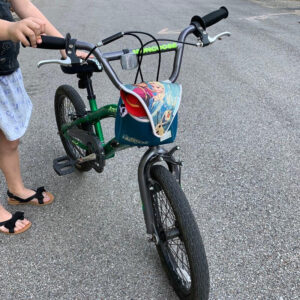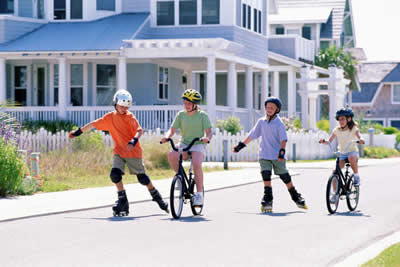Hard Time Learning to 🚲 Ride?
There are FOUR aspects of coordination required.
I’ve written about biking before, but usually from an injury perspective.
This is the time of year that younger children are testing out new bikes, and parents are trying to teach bike riding skills.
With success, the joy is unbelievable.
When the skills just don’t happen, the frustration and doubt run deep.
This is when a little Bridging® can problem solve about why the skill is a challenge, and get your child over the hump!
Riding a bike — it either evokes a sense of pure joy or pure terror!
The joy comes from the new found independence that a bike brings. Cycling is an activity shared by many ages, enabling families to participate in a common activity. It also lets children explore with friends, and expand their awareness of the neighborhood. For older kids, a bike becomes a needed mode of transportation for school and activities.
On the other hand, the fear and trepidation come from several aspects of biking — fear of falling, fear of being hit, fear of getting lost — just to name a few.
Sometimes your child needs a little help, then they figure it out. Sometimes a little help doesn’t work and your child feels left out and frustrated. You feel frustrated and helpless. Maybe they’ll get it next week, or next year.
But what if they don’t? That’s the kind of worry, as a parent, that keeps you up at night. What can you do to help your child master this important skill?
Did you realize there are FOUR distinct aspects of simultaneous coordination required to ride a bike?
Figuring out which one is holding your child back is the key. Bridging® finds the specific gaps and supports them, allowing your child’s body to put all the pieces together! They are discussed in more detail below.
If you are one of the families whose child picked up a bike and started riding after one of our sessions, I’d love to hear your story again. Email me!
The four aspects of coordination required for bike riding
 Commonly it is assumed the primary inhibitor to bike riding is balancing. In reality there is so much more!
Commonly it is assumed the primary inhibitor to bike riding is balancing. In reality there is so much more!
When any one of these four aspects of coordination isn’t working so well, bike riding isn’t easy or safe. What’s even harder, is that the four different skills are in different physical orientations. (Think rubbing your belly and patting your head!)
Here are the four aspects of coordination needed:
- Balance control – The core and head react to control how far we fall to each side before activating the necessary muscles to re-center the body. The direction of this control is side-to-side.
- Pedaling power – The feet, legs, and core need to link up together to affect force enough to push the pedals. The direction of this control is forward and back.
- Steering rotation – The arms coordinate keeping the handle bars straight or turning to each side in a gradual manner, to smoothly navigate curves and turns. The direction of control is rotational.
- Head/visual processing – The head and eyes need to both focus on the landscape to the front, while scanning the environment for changes at the sides, especially at intersections. The direction of the head and eyes are up/down and left/right.
What are some of the reasons these individual skills don’t work well?
We find there is usually a disruptor in life that has either prevented these skills from maturing, or a trauma which upset the way the skills work together.
These traumas and disruptors can come from different points in our lives. We like to group them by the following periods:
- Child/Adult: In these time periods, we find injuries and medical procedures are the usual disruptors in the multi-faceted coordination needed for bike-riding.
- Infant/Toddler/Preschooler: From this time period, there are both developmental aspects which may not have matured synchronously, as well as injuries and medical procedures. Any of these can create a challenge for all of the types of coordination for bike-riding successfully coming together.
- Prenatal/Birth: There are so many unique scenarios which upset the ability of a newborn to link their body to their balance control and visual development. Some of the most common we find are c-section births, umbilical cord issues, long labor, being a multiple, or developing in a breech position.
By pinpointing where the body’s organization got off-track, related to the specific skills for bike riding, we use Bridging®’s gentle micromovements and stretches for a reset. Away you go!
More to helping master coordination …
When your child gets so frustrated that they are about to give up on learning to ride their bike, it’s time to see if a couple sessions of Bridging® will get them over the hump.
For teens and adults, you may also experience some frustration with your physical skills, usually after an injury or procedure. You’ve given things time and done all the rehab exercises, but still not feeling up to what you used to do. Bridging® is able to quickly find and support the missing connections.
At The Bridging® Institute our clients are often surprised by how fast they improve. Uniquely, our approach goes back to early development as the secret.
Recreating early layers of muscle and joint interconnections is the roadmap for sustainably resetting your (or your child’s) body to learn new physical skills. Bridging® rebuilds the original developmental movement foundation; your daily activity reinforces the better function.
Wondering if Bridging® can help?
Fill out our intake form and we’ll get back to you with insights on how Bridging® can help. Virtual or in-office sessions are two options we offer to get you back to feeling your best.

